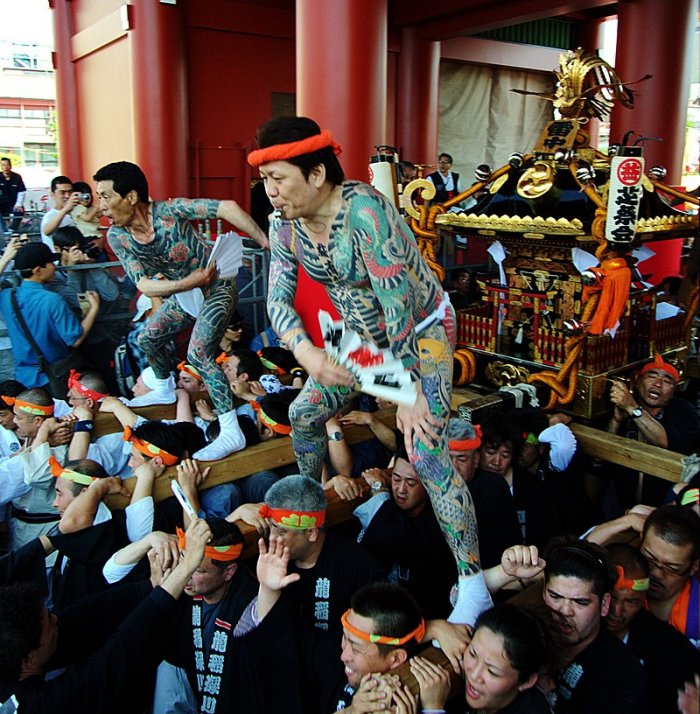Conny Waters – AncientPages.com – The Yakuza is a mafia-like Japanese criminal organization that appeared during the Tokugawa Shogunate (1603 – 1868). It was formed by two separate groups of outcasts, the tekiya and the burakumin.
Tekiya And Burakumin Were Outcasts In The Japanese Society
Many of the first yakuza members were the burakumin, who were a socioeconomic minority in Japan. Though the name burakumin literally means “people of the village,” these people lived in restricted neighborhoods that were ghettos. They were considered filthy individuals and poorly treated.

The yakuza emerged during the Edo period in Japan. Credit: Adobe Stock – blindblues
In 1603 a new law forced the burakumin out of the cities, and they lost all social rights. Referred to as non-humans, the burakumin found themselves below the four-tiered Japanese feudal social structure.
Living in extreme poverty, many of the burakumin turned to crime to survive. They organized themselves, created small criminal groups that eventually grew when new members joined. Gambling was illegal in Japan, but this did not stop the burakumins who were involved in or participated in gambling. As time pᴀssed, they expanded their criminal activities to blackmail, smuggling, prosтιтution, drug trafficking, and loan sharking.
These criminal activities were profitable and attractive to newcomers who joined the organization. When the burakumins’ criminal organization grew, its members established a strict hierarchy inspired by the traditional Japanese family model with a strong patriarch in charge.
The tekiya or street peddlers, wandered from one village to another, selling cheap, low-quality goods. They were also ranked among the lowest social groups during the Edo period. To survive and earn more money, the tekiya formed organizations that offered paid protection during Shinto festivals.
“So distinctive were the habits of the two groups that Japanese police today still often classify yakuza members as either bakuto or tekiya (although the gangs are now diversified into countless rackets).
The ranks of both groups were largely filled from the same quarters—the poor, the landless, and the delinquents and misfits found in any large society. Each group, however, stuck closely to its unique area of control to such an extent that different groups could operate within the same small territory without conflict: the bakuto along the busy highways and towns of old Japan, the tekiya amid the nation’s growing markets and fairs.
It is to these rustic bands of itinerant traders and roadside gamblers that Goro Fujita traces back yakuza genealogy in his One Hundred Year History. Through his oral histories with yakuza elders, research at Japan’s modern libraries, and even field trips to the tombstones of ancient Yakuza, Fujita claims to be able to link today’s godfathers to a criminal lineage extending back to the mid-1700s,” David E. Kaplan writes in the book Yakuza: Japan’s Criminal Underworld.
Yakuza’s Tattoos And Missing Fingers
The Yakuza got its name from the card game Oicho-Kabu. The yakuza members adopted this name because they thought themselves to be society’s worst “hand” with all odds against it. Having cards 8, 9, and 3 is considered the worst combination. The card combination is called ya-ku-za can be translated as useless.

Yakuza often take part in local festivals such as Sanja Matsuri where they often ride the shrine through the streets proudly showing off their elaborate tattoos. Credit: apes_abroad – CC BY-SA 2.0
Traditional Yakuza members are characterized by tattoos that often cover the whole body. According to Adelstein, “the tattoos and missing fingers comprised the most striking, immediate features of these new criminals. They were not ordinary tattoos, but magnificent, full-color designs of samurai warriors, flowers, and dragons that stretched across the body from neck to calf. And the mutilated fingers—these were the ceremoniously severed tops of the smallest digit, lopped off at the joint and presented to the gang leader as a mark of atonement.” 1
The Yakuza members have also adopted Samurai-like rituals.
In the early 1960s, the Yakuza had approximately 184,000, but the Japanese government’s stricter laws against criminal groups had a positive effect. In the early 21 century, the number declined to around 80,000.
Nevertheless, there are still experts who warn “the yakuza are transitioning into powerful organizations and becoming increasingly international.” 2
The background story of the Yakuza is the organization was born out of poverty.
Updated on January 25, 2023
Written by Conny Waters – AncientPages.com Staff Writer
Copyright © AncientPages.com All rights reserved. This material may not be published, broadcast, rewritten or redistributed in whole or part without the express written permission of AncientPages.com
Expand for references
- David E. Kaplan – Yakuza: Japan’s Criminal Underworld
- Adelstein, Jake. “Global Vice: The Expanding Territory Of The Yakuza.” Journal of International Affairs 66, no. 1 (2012): 155-61





